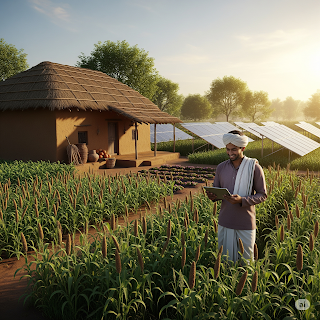A Legacy at a Crossroads
In India, ancestral farms are more than land—they are repositories of tradition, culture, identity, and survival. Yet as climate, markets, and youth preferences evolve, many farmers are torn:
How do you modernize your family farm without losing its soul?
With the right tools and mindset, it’s possible to upgrade productivity, sustainability, and profitability, all while preserving heritage, biodiversity, and family values.
This blog explores how to achieve that delicate balance—using real examples, science-backed strategies, and policy supports available in 2025.
🧭 Step 1: Define What Makes the Farm “Its Soul”
Before upgrading tech or machinery, understand what defines your ancestral farm:
-
Is it a unique crop or traditional variety?
-
A family practice, like seed saving or intercropping?
-
An architecture, water system, or ancient irrigation layout?
-
Is it about community relationships, labor traditions, or festivals?
Preserving this core will ensure modernization doesn’t feel like erasure.
"Soul is in the details—like using neem to protect stored grains or celebrating harvest with neighbors."
🌱 Step 2: Upgrade Soil, Not Just Machines
Instead of just buying tractors or drones, start with soil intelligence:
-
Test soil health through government labs or services like Krishi Vigyan Kendras (KVKs)
-
Use biofertilizers, vermicompost, and microbial cultures like Jeevamrut
-
Integrate crop rotation and cover cropping to preserve long-term fertility
Example: A family in Chhindwara, MP, revived their ancestral black soil by switching from urea-heavy farming to cow dung + neem cake + drip irrigation. Yields rose, pests dropped.
☀️ Step 3: Go Smart, Not Flashy—With Tech That Works
Affordable Tech to Modernize Without Waste:
| Tech Tool | Purpose | Tradition Friendly? |
|---|---|---|
| Solar Pumps | Off-grid irrigation | ✅ (preserves layout) |
| Drip Irrigation | Water-efficient | ✅ (supports local crops) |
| Mobile Soil Sensors | Informed decisions | ✅ |
| Weather Apps (e.g. Skymet) | Smart planting | ✅ |
| eNAM/Mandi Apps | Direct market access | ✅ |
| Cow-Driven Composters | Retain animals’ role | ✅ |
Avoid overly industrial systems unless you're shifting to full-scale agribusiness.
📖 Case Study: Rekindling a Farm in Tamil Nadu
Ravi Shankar, an IT-returned youth, went back to his ancestral 2.5-acre farm in Erode. His goals:
-
Keep the traditional red rice variety
-
Introduce water-saving irrigation
-
Set up a farm stay to revive rural tourism
He used:
-
Solar fencing to protect the crop
-
Digital marketing via Instagram to sell red rice
-
A farm pond with native fish, maintaining biodiversity
Today, the farm is profitable, zero-chemical, and draws visitors for farm tours.
“I didn’t replace tradition. I digitized it.”
💧 Step 4: Water Wisdom—Modernize Harvesting, Not Deplete It
Traditional farms often have:
-
Ancient tank systems
-
Check dams, naalas, or baolis (wells)
-
Contour bunds for slope farming
Instead of ditching these:
-
Restore old tanks using MGNREGA funds
-
Integrate rooftop harvesting with tank irrigation
-
Digitize water usage with flow meters
Policy Support:
-
Jal Shakti Abhiyan: Grants for well/tank revival
-
PM-KUSUM: Subsidies for solar water pumps
-
Atal Bhujal Yojana: Water budgeting and recharge programs
🧺 Step 5: Combine Traditional Crops With New Markets
| Heritage Crop | Region | New Market |
|---|---|---|
| Kalanamak Rice | Eastern UP | Organic rice retailers |
| Millets (Ragi, Bajra) | Pan-India | Health-conscious urban buyers |
| Moringa/Drumstick | South India | Ayurveda, export |
| Indigo/Natural Dyes | Tamil Nadu, Bengal | Sustainable fashion brands |
| Desi Cotton (Karunganni) | Maharashtra | Handloom revival |
📦 Use e-commerce platforms like Amazon Karigar, KisanKonnect, or your own Shopify store.
🛠️ Step 6: Make Infrastructure Smart & Heritage Friendly
Don’t bulldoze the farmhouse. Reuse and repurpose:
-
Convert cattle sheds into seed storage or biogas units
-
Add solar panels to rooftops
-
Convert mud houses into eco farm stays (popular with urban tourists)
Government schemes like:
-
Rural Tourism under Incredible India
-
NABARD support for farm stays and agritourism
...can support these transitions.
📚 Step 7: Involve the Next Generation
Farms die when the youth disconnects. Bridge the gap:
-
Let kids run the digital side: social media, e-commerce, drone ops
-
Use tools like FarmERP, BharatAgri, and agri analytics apps
-
Celebrate local wisdom (soil signs, weather predictions) alongside AI
“Your grandfather’s monsoon sense and your daughter’s weather app can coexist.”
🛡️ Step 8: Protect What Matters—Land, Trees, Seed, and Story
Protect:
-
Heirloom seeds (save and store with the help of seed banks)
-
Family wells, trees, shrines—they hold spiritual and ecological value
-
Land titles and boundaries (digitize them under Digital India Land Records Modernization Program)
Keep a farm journal: record festivals, planting rituals, yield variations. This oral history turns into heritage documentation.
🔄 Final Thoughts: Innovation Rooted in Identity
Modernizing your ancestral farm isn’t about replacing tradition—it’s about enhancing it with tools that respect your land, history, and community. Done right, you preserve the soul of the soil while adding resilience, profitability, and purpose.
“The future of Indian farming isn’t in forgetting the past—but in digitizing its wisdom.”

No comments:
Post a Comment